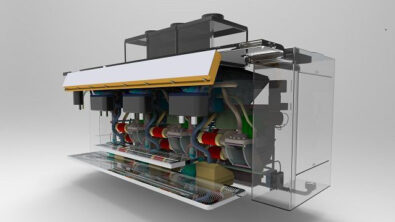Create Reliable, Sustainable, and Customizable Products using Detailed Simulation

Detailed product simulation in the consumer packages goods industry is necessary to stay on top of addressing ever-evolving consumer demand. The significant shift in consumer buying habits and trends is prompting consumer goods manufacturers to expedite new ways to adapt and transform their product development and design processes.
In addition to unpredictable purchasing behavior, consumer goods manufacturers are challenged with complexities in product development and packaging creation, maintaining environmental stewardship throughout the production process, and staying one step ahead of the competition.
Multiple benefits to digital simulation
Changes in purchasing behavior are likely to have long-term consequences. Consumer goods manufacturers who invest in innovative solutions over time will maintain operational efficiencies, reduce costs and time-to-market, and address changes in customer expectations head-on.
Consumer goods manufacturers benefit from a variety of advantages of detailed simulation processes, including design automation, formulation, specification management, and virtual validation, ensuring that brands can successfully launch new and personalized products that meet the demand of consumers.
A few benefits to adopting simulation include:
- Minimized design and testing efforts and reduced time-to-market:
The days of unwavering customer loyalty are long gone. Competing products that provide a better experience can now easily sway consumers, and packaging design has become as important as the product itself.
Consumer goods and goods companies that sell products must constantly optimize design in order to remain competitive. A product that is not made in a sustainable manner, has poor packaging, or lacks the personal touch that customers seek can deter them from purchasing it.
Simulation transforms the design process for designers and engineers. Not only can detailed simulation form in real-world scenarios, such as what happens if a product is dropped or the packaging is damaged, but it can also show how the product will respond in those situations. It also vastly expands the number of design options that can be tested, far exceeding the limitations of physical prototyping. Because thousands of design variations can be tested in parallel, your improved designs can be ready for production in a fraction of the time that traditional processes would take.
- Sustainability
Today’s consumers are putting their money where the environment is and are increasingly willing to sacrifice their favorite brands and products for more sustainable choices. Consumer products and goods companies are under pressure to use sustainable or recycled packaging materials and to use less energy and water while maintaining quality.
Digital simulation can predict how much waste and emissions a design will generate, what materials can be reused elsewhere, and, most importantly, whether sustainable options will perform the same function as non-sustainable materials.
By moving away from trial-and-error prototypes, the virtual approach allows businesses to test a wide range of sustainable designs and accelerates the process of bringing new packaging to market while minimizing physical waste. As a result, simulation is an efficient and sustainable way to address the urgent environmental challenge while keeping consumers on board.
- Improved customer experience
The days of steadfast consumer loyalty are long gone. Consumers can now be easily swayed by competing products that provide a better experience, and packaging design has become as important as the product itself.
To remain competitive, consumer products and goods companies that sell products must constantly optimize design. A dripping nozzle, product that dispenses too quickly or too slowly, or a bottle that is simply too heavy can all put a consumer off purchasing it.
For designers and engineers, simulation transforms the bottle design process. Not only can computational fluid dynamics show how a bottle will perform in real-world scenarios such as being dropped or squeezed, but it can also show how the product inside will behave in those situations. It also significantly increases the number of bottle design options that can be tested, exceeding the limitations of physical prototyping.
- Reducing costs while accelerating time to market
Simulation is critical in actively reducing costs for consumer packaged goods companies. It can not only eliminate the need for costly and often inefficient physical prototypes, but it can also validate and optimize specific cost-cutting initiatives such as changes in packaging material or product design.
Designers can test multiple configurations and material combinations far more efficiently than they could with physical prototypes and trial and error by applying real-world conditions to virtual models.
They can also learn a lot about where stress is concentrated when a bottle is dropped, squeezed, or packed for shipping. These discoveries result in packaging that improves both the customer experience and the bottom line.
Stay competitive to meet consumers’ needs
Manufacturers need solutions to create flexible and sustainable products. Solutions that maintain their quality and compliances while lowering production costs are also crucial elements. Moreover, to stay competitive and relevant, brands must adapt product design and simulation strategies. Adopting such solutions allows manufacturers to get products to market faster.
You can easily create reliable, sustainable, and customizable products using Smart Processes and Product Design. Take the journey from imagining to creating human-centered products that fit consumers’ needs.
Want to learn more? Read the eBook


